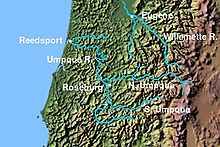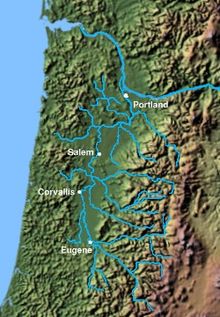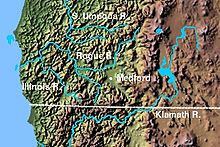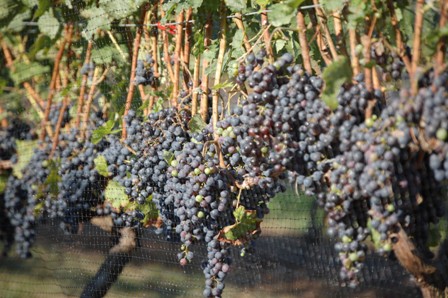|
Oregon Red Wine, Pinot Noir - New World Vines with Old World Finds
Oregon Red Wine Go To: History Oregon red wine has been produced since the Oregon Territory was settled in the 1840s; however, winemaking has only been a significant industry in the state since the 1960s. Grapes were first planted in the Oregon Territory in 1847, with the first recorded winery being established in 1850 in Jacksonville. Throughout the 19th century, there was experimentation with various varietals by immigrants to the state. In 1904, an Oregon winemaker won a prize at the St. Louis World's Fair. Oregon red wine production stopped in the United States during Prohibition. As in other states, the Oregon red wine industry lay dormant for thirty years after Prohibition was repealed.The Oregon red wine industry started to rebuild in the 1960s, when California winemakers opened several vineyards in the state. This included the planting of Pinot Noir grapes in the Willamette Valley, a region long thought too cold to be suitable for viticulture. In the 1970s, more out-of-state winemakers migrated to the state and started to organize as an industry. The state's land use laws had prevented rural hillsides from being turned into housing tracts, preserving a significant amount of land suitable for vineyards. In 1979, a 1975 Pinot Noir was entered into theWine Olympics; the Oregon red wine was rated among the top Pinots in the world, thus gaining the region its first international recognition. The accolades continued into the 1980s, and the Oregon red wine industry continued to add both wineries and vineyards. The state industry continued to market itself, establishing the first of several AVAs (American Viticulture Areas) in the state. The state also grew strong ties with the Burgundy region of France. In the early 1990s, the Oregon red wine industry was threatened by a Phylloxera infestation in the state, but winemakers quickly turned to the use of resistant rootstocks to prevent any serious damage. The state legislature enacted several new laws designed to promote winemaking and wine distribution. The state found a newfound focus on "green" winemaking, leading the global wine industry into more environmentally friendly practices. Several new AVAs were established. By 2005, there were 314 wineries and 519 vineyards in operation in Oregon.
There are, loosely speaking, three main wine producing regions with a major presence in the state of Oregon, as defined by non-overlapping American Viticultural Areas. Two of them—the Willamette Valley AVA and the Southern Oregon AVA—are wholly contained within Oregon; a third, the Columbia Gorge AVA straddles the Columbia River and includes territory in both Oregon and Washington; however, this AVA is considered to be an Oregon AVA. Portions of the Walla Walla Valley AVA, an area which is primarily in Washington (along with the Columbia Valley AVA which contains it), descend into Oregon in the Milton-Freewater area. The Southern Oregon AVA was recently created as the union of two Southern Oregon winegrowing regions long considered distinct, the Rogue Valley and the Umpqua Valley. Several other smaller AVAs are found within some of these larger regions. The Snake River Valley AVA, which straddles Oregon's border with Idaho along the Snake River, is the first AVA to include a part of Eastern Oregon. Willamette Valley The Willamette Valley AVA is the wine growing region which encompasses the Willamette Valley. It stretches from the Columbia River in the north to just south of Eugene in the south, where the Willamette Valley ends; and from the Oregon Coast Range in the West to the Cascade Mountains in the East. At 5,200 square miles (13,500 km2), it is the largest AVA in the state, and contains most of the state's wineries; approximately 200 as of 2006. The climate of Willamette Valley is mild year-round, with cool, wet winters and warm, dry summers; extreme temperatures are uncommon. Most rainfall occurs outside the growing season and the valley gets relatively little snow. Not all parts of the Valley are suitable for viticulture, and most wineries and vineyards are found west of the Willamette River, with the largest concentration in Yamhill County. This region is most famous for its Pinot Noir, and also produces large amounts of Pinot Gris, Riesling, and Chardonnay. The region also produces Cabernet Sauvignon, Gewürztraminer, Müller-Thurgau, Sémillon, and Zinfandel grapes, but in far smaller quantities. The region is divided into four subordinate AVAs: Dundee Hills AVA, McMinnville AVA, Ribbon Ridge AVA, and the Yamhill-Carlton District AVA. Two more AVA applications are pending. In addition, many wine connoisseurs further divide the Willamette Valley into northern and southern regions approximately at the latitude of Salem. Southern Oregon The Southern Oregon AVA is an AVA which was formed as the union of two existing AVAs—the Rogue Valley AVA and the Umpqua Valley AVA. (A small strip of connecting territory is included in the Southern Oregon AVA to make it a contiguous region; however, this strip passes through mountains regions not suitable for vineyards.) This AVA was established in 2004 to allow the two principal regions in Southern Oregon to jointly market themselves. As the Rogue Valley and Umpqua Valley regions produce different grapes and different varietals, they are examined separately.

Umpqua Valley The Umpqua Valley AVA contains the drainage basin of the Umpqua River, excluding mountainous regions. The Umpqua Valley has a warmer climate than the Willamette Valley, but is cooler than the Rogue Valley to the south. Grapes grown here include Pinot Noir, with smaller amounts of Pinot Gris, Cabernet Sauvignon, Chardonnay, and Riesling, as well as several French-American hybrids. The region includes one sub-AVA, the Red Hill Douglas County, Oregon AVA.
Rogue Valley The Rogue Valley AVA includes the drainage basin of the Rogue River and several tributaries, including the Illinois River, the Applegate River, and Bear Creek. Most wineries in the region are found along one of these three tributaries, rather than along the Rogue River itself. The region is 70 miles (110 km) wide by 60 miles (100 km) long (although much of the land within the AVA is not suitable for grape cultivation); there are currently 32 wineries with only 1,100 acres (4 km2) planted. The three valleys differ greatly in terroir, with the easternmost Bear Creek valley being warmest and driest, and the westernmost Illinois River valley being coolest and wettest. Each river valley has a unique climate and grows different varieties of grapes. Overall, however, this region is the warmest and driest of Oregon's red wine-growing regions. The region has one sub-AVA, the Applegate Valley AVA. Columbia Gorge The Columbia Gorge AVA is found in the Columbia Gorge. This region straddles the Columbia River, and thus lies in both Oregon and Washington; it is made up of Hood River and Wasco counties in Oregon, and Skamania and Klickitat counties in Washington. The region lies to the east of the summits of nearby Mount Hood and Mount Adams, situated in their rain shadows; thus, the region is significantly drier than the Willamette Valley. It also exhibits significant differences in elevation due to gorge geography, and strong winds common in the area also play a factor in the region's climate. This allows a wide variety of grapes to be grown in the Columbia Gorge. The region has nearly 40 vineyards, growing a wide variety of grapes, including Syrah, Pinot Noir, Chardonnay, Gewürztraminer, Zinfandel, Cabernet, Pinot Gris, Riesling, and Sangiovese. Walla Walla Valley Portions of northeastern Oregon (in the vicinity of Milton-Freewater) are part of the Walla Walla Valley AVA, which was established in 1984. This appellation, which is part of the Columbia Valley AVA, lies primarily within Washington state. This region has nearly 100 wineries and 1,200 acres (5 km2) planted. Wines grown in the valley include Syrah, Merlot, and Cabernet Sauvignon, as well as Sangiovese and a few exotic varietals including Counoise, Carmenère, Mourvèdre, Cabernet Franc, Nebbiolo and Barbera. Snake River Valley A new viticultural area along the Snake River was established on April 9, 2007. Principally located in Idaho, the area also encompasses two large counties in Eastern Oregon, Baker County and Malheur County. The region's climate is unique among AVAs in Oregon; the average temperature is relatively cool and rainfall is low, creating a shorter growing season. Current production is led by hardy grapes such as Riesling, Gewürztraminer, and Chardonnay. The climate also lends itself extremely well to the production of ice wine. However, the AVA is quite large and warmer microclimates within the area can also support different types of grapes such as Cabernet Sauvignon and Merlot.
Like other wines produced in the United States, Oregon red wines are marketed as varietals. Oregon law requires that wines produced in the state must be identified by the grape variety from which it was made, and for most varietals it must contain at least 90% of that variety. The exceptions to the 90% law are the following varietals: Red and White Bordeaux varietals, Red and White Rhône varietals, Sangiovese, Tempranillo, Zinfandel and Tannat. For these Oregon red wines, they follow the Federal guidelines of 75%. Oregon law has long forbidden use of place names, except as appellations of origin. Oregon is most famous for its Pinot Noir, which is produced throughout the state. Pinot Noirs from the Willamette Valley have received much critical acclaim from wine connoisseurs and critics, and Oregon is regarded as one of the premier Pinot-producing regions in the world. In 2005, the top five varieties produced in Oregon were:
* Pinot Noir 7,974 acres * Pinot Gris 1,184 acres * Chardonnay 842 acres * Merlot 550 acres * Riesling 524 acres Other varieties with significant production in Oregon include Cabernet Sauvignon, Gewürztraminer, Müller-Thurgau, Pinot blanc, Sauvignon blanc, Sémillon, and Syrah. V. vinifera based wines produced in smaller quantities include Arneis, Baco noir, Cabernet franc, Chenin blanc, Dolcetto, Gamay Noir, Grenache, Marechal Foch, Malbec, Muscat, Nebbiolo, Petite Syrah, Sangiovese, Tempranillo, Viognier, and Zinfandel. The state also produces sparkling wine, late harvest wine, ice wine, and dessert wine.
Oregon Red Wine Go To: Thank you Wikipedia for the content of this page.
Return from Oregon Red Wine to Types of Red Wine
|
Sign up for weekly Red Wine Reviews
CLICK HEREWe will send you the extremely popular Red-Wine-Home tasting terms when you sign-up.








